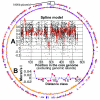Toward a more robust assessment of intraspecies diversity, using fewer genetic markers
- PMID: 16980418
- PMCID: PMC1636164
- DOI: 10.1128/AEM.01398-06
Toward a more robust assessment of intraspecies diversity, using fewer genetic markers
Abstract
Phylogenetic sequence analysis of single or multiple genes has dominated the study and census of the genetic diversity among closely related bacteria. It remains unclear, however, how the results based on a few genes in the genome correlate with whole-genome-based relatedness and what genes (if any) best reflect whole-genome-level relatedness and hence should be preferentially used to economize on cost and to improve accuracy. We show here that phylogenies of closely related organisms based on the average nucleotide identity (ANI) of their shared genes correspond accurately to phylogenies based on state-of-the-art analysis of their whole-genome sequences. We use ANI to evaluate the phylogenetic robustness of every gene in the genome and show that almost all core genes, regardless of their functions and positions in the genome, offer robust phylogenetic reconstruction among strains that show 80 to 95% ANI (16S rRNA identity, >98.5%). Lack of elapsed time and, to a lesser extent, horizontal transfer and recombination make the selection of genes more critical for applications that target the intraspecies level, i.e., strains that show >95% ANI according to current standards. A much more accurate phylogeny for the Escherichia coli group was obtained based on just three best-performing genes according to our analysis compared to the concatenated alignment of eight genes that are commonly employed for phylogenetic purposes in this group. Our results are reproducible within the Salmonella, Burkholderia, and Shewanella groups and therefore are expected to have general applicability for microevolution studies, including metagenomic surveys.
Figures






Similar articles
-
Towards a genome-based taxonomy for prokaryotes.J Bacteriol. 2005 Sep;187(18):6258-64. doi: 10.1128/JB.187.18.6258-6264.2005. J Bacteriol. 2005. PMID: 16159757 Free PMC article.
-
dnaJ is a useful phylogenetic marker for alphaproteobacteria.Int J Syst Evol Microbiol. 2008 Dec;58(Pt 12):2839-49. doi: 10.1099/ijs.0.2008/001636-0. Int J Syst Evol Microbiol. 2008. PMID: 19060069
-
Taxon K, a complex within the Burkholderia cepacia complex, comprises at least two novel species, Burkholderia contaminans sp. nov. and Burkholderia lata sp. nov.Int J Syst Evol Microbiol. 2009 Jan;59(Pt 1):102-11. doi: 10.1099/ijs.0.001123-0. Int J Syst Evol Microbiol. 2009. PMID: 19126732
-
Overlapping genes as rare genomic markers: the phylogeny of gamma-Proteobacteria as a case study.Trends Genet. 2006 Nov;22(11):593-6. doi: 10.1016/j.tig.2006.08.011. Epub 2006 Sep 12. Trends Genet. 2006. PMID: 16973237 Review.
-
Phylogenetic understanding of clonal populations in an era of whole genome sequencing.Infect Genet Evol. 2009 Sep;9(5):1010-9. doi: 10.1016/j.meegid.2009.05.014. Epub 2009 May 27. Infect Genet Evol. 2009. PMID: 19477301 Review.
Cited by
-
Spirochetes isolated from arthropods constitute a novel genus Entomospira genus novum within the order Spirochaetales.Sci Rep. 2020 Oct 13;10(1):17053. doi: 10.1038/s41598-020-74033-9. Sci Rep. 2020. PMID: 33051478 Free PMC article.
-
Detection, Characterization, and Typing of Shiga Toxin-Producing Escherichia coli.Front Microbiol. 2016 Apr 12;7:478. doi: 10.3389/fmicb.2016.00478. eCollection 2016. Front Microbiol. 2016. PMID: 27148176 Free PMC article. Review.
-
A database for the taxonomic and phylogenetic identification of the genus Bradyrhizobium using multilocus sequence analysis.BMC Genomics. 2015;16 Suppl 5(Suppl 5):S10. doi: 10.1186/1471-2164-16-S5-S10. Epub 2015 May 26. BMC Genomics. 2015. PMID: 26040196 Free PMC article.
-
Evaluation of a Method Using Three Genomic Guided Escherichia coli Markers for Phylogenetic Typing of E. coli Isolates of Various Genetic Backgrounds.J Clin Microbiol. 2015 Jun;53(6):1848-53. doi: 10.1128/JCM.00227-15. Epub 2015 Mar 25. J Clin Microbiol. 2015. PMID: 25809972 Free PMC article.
-
DNA enrichment and tagmentation method for species-level identification and strain-level differentiation using ON-rep-seq.Commun Biol. 2019 Oct 10;2:369. doi: 10.1038/s42003-019-0617-x. eCollection 2019. Commun Biol. 2019. PMID: 31633060 Free PMC article.
References
-
- Adiri, R. S., U. Gophna, and E. Z. Ron. 2003. Multilocus sequence typing (MLST) of Escherichia coli O78 strains. FEMS Microbiol. Lett. 222:199-203. - PubMed
-
- Ciccarelli, F. D., T. Doerks, C. von Mering, C. J. Creevey, B. Snel, and P. Bork. 2006. Toward automatic reconstruction of a highly resolved tree of life. Science 311:1283-1287. - PubMed
-
- Feil, E. J. 2004. Small change: keeping pace with microevolution. Nat. Rev. Microbiol. 2:483-495. - PubMed
Publication types
MeSH terms
Substances
LinkOut - more resources
Full Text Sources
Other Literature Sources
Molecular Biology Databases

